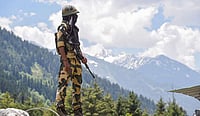Scientists have expressed concerns about the possibility of viruses and bacterias frozen in the Earth's ice for millions of years getting released.
Scientists have said that there is a possibility that these pathogens, which have been dormant for millions of years, could leak naturally or from lab.
Since these pathogens have never been studied, it's not clear how they would affect humans or any species they infect. This is part of the concern.
Here we explain why are scientists concerned about these pathogens, how they could escape, and what latest research says on this.
Why are scientists concerned about pathogens frozen in ice?
Pathogens have been frozen in the Earth's ice for millions of years, but there is no guarantee that they would remain frozen. The issue is global warming.
The Earth's ice is melting at record pace and it's not just our riverine glaciers that are melting but polar icecaps and permafrost have also been affected.
These regions have been covered in ice for millions of years and are believed to have pathogens that are 'sleeping' there for all this while. Scientists are concerned that if and when these pathogens 'wake up', they could destabilise the species they infect.
To put the timeframe into perspective, modern humans appeared just around 3,00,000 years ago. These pathogens, therefore, have been sleeping for hundreds of thousand of years before the first humans began walking on the Earth.
Scientists are not just concerned that the melting ice could release these pathogens into the world. They are also concerned that scientists collecting these viruses for research purposes could have a lab-accident that could cause a leak of these viruses or bacterias. After all, there have been several instances of lab-leaks and at least one pandemic --the 1977 H1N1 pandemic-- is understood to have a lab-origin now, as per Alina Chan and Matt Ridley's book VIRAL: The Search for the Origin of Covid-19.
The latest research, published in a paper titled 'Time-travelling pathogens and their risk to ecological communities' in PLOS Computational Biology journal says: "Permafrost thawing and the potential ‘lab leak’ of ancient microorganisms generate risks of biological invasions for today’s ecological communities, including threats to human health via exposure to emergent pathogens...The unprecedented rates of melting of glaciers and permafrost are now giving many types of ice-dormant microorganisms concrete opportunities to re-emerge, bring- ing to the fore questions about their potential."
What does the latest research say?
In the research published in PLOS Computational Biology, the multinational team led by Giovanni Strona of University of Helsinki simulates a 'biological invasion'.
In simple terms, these scientists simulated through a computer program how an invasion of these 'sleeping' pathogens could play out on existing species.
Consequences of a successful invasion could be severe, note researchers.
"When a species is moved passively or actively from its range to a new locality with different environmental and ecological conditions, the consequences for native communities are unpredictable, but are often exceptionally severe when they succeed. When catastrophic invasions do occur, it is most often a consequence of the lack of co-adaptation between the invader and native species. Sharing a co-evolutionary history requires prolonged temporal and spatial overlap of species occurrence, but there is no such shared history when an alien species is first introduced into a naïve community," notes the study.
The study notes that even though the opportunities for biological invasions have grown exponentially with globalisation, most invasion attempts are expected to fail. It further notes that since most of these situations would be highly contextualised, predicting them via computer simulations is not entirely possible.
However, the study's "results suggest that an invader commonly becomes successfully established in the recipient community".
Scientists 'waking up' sleeping pathogens
While the study by Strona et al looks at computer simulations, there have been multiple incidents in the past decade when scientists have revived pathogens 'sleeping' for a very long time for research purposes.
In 2014, scientists said a 30,000-year-old virus had come to life. For all those years, it had been dormant in the Siberian permafrost, but as the ice cracked, the virus came to the fore and 'woke up'. In 2022 in the same Siberian region, reports said that scientists revived 'zombie viruses', one of which had been dormant for 50,000 years. "While the record-breaking virus [the one around 50,000-years-old] was found beneath a lake, other extraction locations included mammoth wool and the intestines of a Siberian wolf – all buried beneath permafrost. Using live single-cell amoeba cultures, the team proved that the viruses still had the potential to be infectious pathogens," reported Science Alert.
There is already some evidence that such pathogens which 'wake up' after ice melts could infect nearby species. The Strona et al study cites one such case: "Similar events of reappearance of bygone pathogens often result in severe infections, such as when several people in Siberia were exposed to anthrax spores likely coming from carcasses of infected, long-dead animals buried in permafrost, which were released by ice thawing."
One reason why scientists are concerned about such pathogens is that we don't know anything about them, so we would need to learn to treat them from the scratch in case they lead to an outbreak.
"More than 100 diverse microorganisms in Siberia’s deep permafrost have been found to be antibiotic resistant. As the permafrost thaws, there is potential for these bacteria to mix with meltwater and create new antibiotic-resistant strains," notes a paper titled 'Emergent biogeochemical risks from Arctic permafrost degradation' in Nature Climate Change Journal.


























